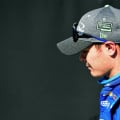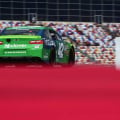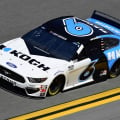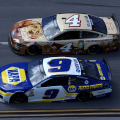Cutting off the engine at the start/finish line is common. In qualifying, it’s far more common as the grills on the cars are fully taped up and they run hot toward the end of a qualifying run.
However, many drivers also do it in practice.
On Wednesday and Friday of last week, NASCAR hosted a test for the Next Gen car at Charlotte Motor Speedway. The two-day test saw multiple packages in use as the sanctioning body tweaks the rules package for the 2022 season.
Fans were allowed in the stands for the test. One fan loved the sound of the car rolling by at high speed, with the engine shut off.
Brad Keselowski would kill the engine at the start/finish line, at the end of every run. He would then roll into turn one with no engine noise, allowing fans to hear only the whoosh of the machine going by.
Keselowski explained why he started doing this…
Keselowski explained, “Early in my career we were testing at IRP and the engine blew on the last lap of the test. We couldn’t afford to fix it and I almost never raced again. From there on out I always shut the engine off rather than drive it in. Never know when you’ll need that extra lap of engine.”
The fan video that sparked the explanation is shown below.
Related: Charlotte Testing Results – December 17, 2021 (NASCAR Next Gen)
NASCAR Next Gen
Testing Video
Keselowski talks the NASCAR Next Gen
NASCAR used multiple configurations during the two-day test. On Wednesday, a 550-hp engine was in use. For the rest of the test, the 670-hp engine took it’s place and appears to be the direction NASCAR is going for 2022.
Additionally, multiple aero packages were in play. Beyond more horsepower, NASCAR also decreased drag. They went from a 6″ spoiler to just 4″, the drivers were happy.
“We liked everything today just some more than others. I’m pretty excited about it because the cars are significantly more difficult to drive. If you make a mistake, the penalty is huge. The 4-inch felt like it was 2005 Cup cars,” Keselowski told Bob Pockrass of the different Next Gen packages.
One of the biggest issues is supply. Most teams are low on supply to begin the 2022 season.
For next year, Keselowski becomes a car owner along with piloting the No. 6. That puts him in a unique situation of understanding the management side of the team as well.
For the newly formed Roush Fenway Keselowski Racing, the team expects to have just 5 chassis for the first 5 races. That includes the No. 6 used in the test along with two more for each of the two RFK racing teams.
Keselowski added detail via twitter, “For context- This is the largest concern of #Nextgen to date and will correct itself appropriately over time. The positive is that the cars are so far proving to be a significant improvement in terms of how they require talent to drive & cost to operate- compared to years past.”
The official debut for the Next Gen car is set for February 6, 2022. The season opens with the Busch Clash inside the LA Coliseum.
Related: NASCAR Next Gen testing schedule updated
Links
Brad Keselowski | Roush Fenway Keselowski Racing | Charlotte Motor Speedway | NASCAR



